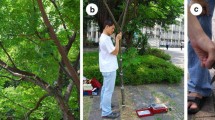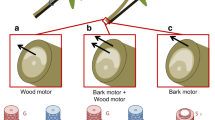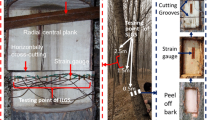Abstract
Key message
Stem reorientation is critical to tree survival. With anatomical observation and strain measurement, the tension wood formation and biomechanical behavior were studied to gain insights into tree uprighting process.
Abstract
Tension wood plays a role in maintaining the mechanical stability of angiosperm trees. Both biological and physical aspects of tension wood are essential in understanding the mechanism of trunk or branch reorientation. In this study, we worked on both tension wood formation and its biomechanical function in artificially inclined 2-year-old Koelreuteria henryi seedlings. The tension wood formation and reorientation process of the trunk last for about 3 months. With pinning method, we confirmed that at the beginning of inclination the cambial zone including the vascular cambium and the developing normal wood fibers on the upper side of the inclined trunk perceives the onset of mechanical change and starts to produce G-fibers that generate a strong contractile released growth strain (RGS) for gravitropic correction. Stronger contractile RGS and more tension wood were found at the trunk base than at the half-height, suggesting that the trunk base plays a key role in trunk uprighting of K. henryi seedlings. The eccentric cambial growth in the tension wood side increases the efficiency of gravitropic correction and the compressive strains measured in the opposite wood of some inclined seedlings also help the upright movement.










Similar content being viewed by others
References
Alméras T, Fournier M (2009) Biomechanical design and long-term stability of trees: morphological and wood traits involved in the balance between weight increase and the gravitropic reaction. J Theor Biol 256:370–381
Alméras T, Thibaut A, Gril J (2005) Effect of circumferential heterogeneity of wood maturation strain, modulus of elasticity and radial growth on the regulation of stem orientation in trees. Trees 19(4):457–467
Alméras T, Derycke M, Jaouen G, Beauchene J, Fournier M (2009) Functional diversity in gravitropic reaction among tropical seedlings in relation to ecological and developmental traits. J Exp Bot 60(15):4397–4410
Archer RR (1986) Growth stresses and strains in tress. Springer, Berlin
Baba K, Park YW, Kaku T, Kaida R, Takeuchi M, Yoshida M, Hosoo Y, Ojio Y, Okuyama T, Taniguchi T, Ohmiya Y, Kondo T, Shani Z, Shoseyov O, Awano T, Serada S, Norioka N, Norioka S, Hayashi T (2009) Xyloglucan for generating tensile stress to bend tree stem. Mol Plant 2(5):893–903
Batianoff GN, Butler DW (2002) Assessment of invasive naturalised plants in south-east Queensland. Plant Prot Q 17:27–34
Clair B, Alméras T, Pilate G, Jullien D, Sugiyama J, Riekel C (2011) Maturation stress generation in poplar tension wood studied by synchrotron radiation microdiffraction. Plant Physiol 155(1):562–570
Clair B, Alméras T, Sugiyama J (2006a) Compression stress in opposite wood of angiosperms: observations in chestnut, mani and poplar. Ann For Sci 63(5):507–510
Clair B, Alméras T, Yamamoto H, Okuyama T, Sugiyama J (2006b) Mechanical behavior of cellulose microfibrils in tension wood, in relation with maturation stress generation. Biophys J 91(3):1128–1135
Clair B, Ruelle J, Beauchéne J, Prévost MF, Fournier M (2006c) Tension wood and opposite wood in 21 tropical rain forest species 1. Occurrence and efficiency of the G-layer. IAWA 27(3):329–338
Coutand C, Fournier M, Moulia B (2007) The gravitropic response of poplar trunks: Key roles of prestressed wood regulation and the relative kinetics of cambial growth versus wood maturation. Plant Physiol 144(2):1166–1180
Coutand C, Pot G, Badel E (2014) Mechanosensing is involved in the regulation of autostress levels in tension wood. Trees 28(3):687–697
Doğu AD, Grabner M (2010) A staining method for determining severity of tension wood. Turk J Agric For 34(5):381–392
Donaldson L (2008) Microfibril angle: measurement, variation and relationships—a review. IAWA 29(4):345–386
Duncker P, Spiecker H (2008) Cross-sectional compression wood distribution and its relation to eccentric radial growth in Picea abies [L.] Karst. Dendrochronologia 26(3):195–202
Ewart AJ, Mason-Jones AJ (1906) The formation of red wood in conifers. Ann Bot 20:201–204
Fang CH, Clair B, Gril J, Alméras T (2007) Transverse shrinkage in G-fibers as a function of cell wall layering and growth strain. Wood Sci Technol 41:659–671
Fang CH, Clair B, Gril J, Liu SQ (2008) Growth stresses are highly controlled by the amount of G-layer in poplar tension wood. IAWA 29(3):237–246
Fisher JB, Stevenson JW (1981) Occurrence of reaction wood in branches of dicotyledons and its role in tree architecture. Bot Gaz 142(1):82–95
Fournier M, Bailleres H, Chanson B (1994a) Tree biomechanics: growth, cumulative prestresses, and reorientations. Biomimetics 2(3):229–251
Fournier M, Chanson B, Thibaut B, Guitard D (1994b) Measurements of residual growth strains at the stem surface. Ann For Sci 51(3):249–266
Gardiner B, Barnett J, Saranpa¨a P, Gril J (2014) The biology of reaction wood. Springer, Berlin, p 274
Gričar J, Zupančič M, Čufar K, Oven P (2007) Wood formation in Norway spruce (Picea abies) studied by pinning and intact tissue sampling method. Wood Res 52(2):1–9
Grzeskowiak V, Sassus F, Fournier M (1996) Macroscopic staining, longitudinal shrinkage and growth strains of tension wood of poplar (Populus × euramericana cv I.214). Ann Sci For 53(6):1083–1097
Höster HR, Liese W (1966) On the occurrence of reaction tissue in roots and branches of dictyledons. Holzforschung 20:80–90
Huang YS, Hung LF, Kuo-Huang LL (2010) Biomechanical modeling of gravitropic response of branches: roles of asymmetric periphery growth strain versus self-weight bending effect. Trees 24(6):1151–1161
Jourez B, Avella-Shaw T (2003) Effet de la durée d’application d’un stimulus gravitationnel sur la formation de bois de tension et de bois opposé dans de jeunes pousses de peuplier (Populus euramericana cv ‘Ghoy’). Ann For Sci 60:31–41
Jullien D, Widmann R, Loup C, Thibaut B (2013) Relationship between tree morphology and growth stress in mature European beech stands. Ann For Sci 70(2):133–142
Kuĉera LJ, Philipson WR (1978) Growth eccentricity and reaction anatomy in branchwood of Pseudowintera colorata. Am J Bot 65(6):601–607
Kuo-Huang LL, Chen SS, Huang YS, Chen SJ, Hsieh YI (2007) Growth strains and related wood structures in the leaning trunks and branches of Trochodendron aralioides—a vessel-less dicotyledon. IAWA 28(2):211–222
Mäkinen H, Seo JW, Nöjd P, Schmitt U, Jalkanen R (2008) Seasonal dynamics of wood formation: a comparison between pinning, microcoring and dendrometer measurements. Eur J For Res 127(3):235–245
Matsuzaki J, Masumori M, Tange T (2007) Phototropic bending of non-elongating and radially growing woody stems results from asymmetrical xylem formation. Plant Cell Environ 30(5):646–653
Mellerowicz EJ, Gorshkova TA (2012) Tensional stress generation in gelatinous fibres: a review and possible mechanism based on cell-wall structure and composition. J Exp Bot 63(2):551–565
Mellerowicz EJ, Immerzeel P, Hayashi T (2008) Xyloglucan: the molecular muscle of trees. Ann Bot 102(5):659–665
Moulia B, Coutand C, Lenne C (2006) Posture control and skeletal mechanical acclimation in terrestrial plants: implications for mechanical modeling of plant architecture. Am J Bot 93(10):1477–1489
Mukogawa Y, Nobuchi T, Sahri MJ (2003) Tension wood anatomy in artificially induced leaning stems of some tropical trees. For Res 75:27–33
Nishikubo N, Takahashi J, Roos AA, Derba-Maceluch M, Piens K, Brumer H, Teeri TT, Stalbrand H, Mellerowicz EJ (2011) Xyloglucan endo-transglycosylase-mediated xyloglucan rearrangements in developing wood of hybrid aspen. Plant Physiol 155(1):399–413
Ohashi Y, Sahri MH, Yoshizawa N, Itoh T (2001) Annual rhythm of xylem growth in rubberwood (Hevea brasiliensis) trees grown in Malaysia. Holzforschung 55(2):151–154
Okuyama T, Yamamoto H, Yoshida M, Hattori Y, Archer RR (1994) Growth stresses in tension wood—role of microfibrils and lignification. Ann Sci For 51(3):291–300
Onaka F (1949) Studies on compression- and tension-wood. Mokuzai Gakkaishi 1:1–88
R Core Team (2013) R: a language and environment for statistical computing
Ruelle J, Beauchene J, Yamamoto H, Thibaut B (2011) Variations in physical and mechanical properties between tension and opposite wood from three tropical rainforest species. Wood Sci Technol 45(2):339–357
Ruelle J, Yamamoto H, Thibaut B (2007a) Growth stresses and cellulose structural parameters in tension and normal wood from three tropical rainforest angiosperms species. Bioresources 2(2):235–251
Ruelle J, Yoshida M, Clair B, Thibaut B (2007b) Peculiar tension wood structure in Laetia procera (Poepp.) Eichl. (Flacourtiaceae). Trees 21(3):345–355
Schmitt U, Jalkanen R, Eckstein D (2004) Cambium dynamics of Pinus sylvestris and Betula spp. in the northern boreal forest in Finland. Silva Fenn 38(2):167–178
Scurfield G (1972) Histochemistry of reaction wood cell walls in two species of Eucalyptus and in Tristania conferta R. BR. Aust J Bot 20:9–26
Scurfield G (1973) Reaction wood: its structure and function: lignification may generate the force active in restoring the trunks of leaning trees to the vertical. Science 179(4074):647–655
Sierra-De-Grado R, Pando V, Martinez-Zurimendi P, Penalvo A, Bascones E, Moulia B (2008) Biomechanical differences in the stem straightening process among Pinus pinaster provenances. A new approach for early selection of stem straightness. Tree Physiol 28(6):835–846
Sinnott EW (1952) Reaction wood and the regulation of tree Form. Am J Bot 39(1):69–78
Spurr A (1969) A low-viscosity epoxy resin embedding medium for electron microscopy. J Ultrastruct Res 26:31–43
Thibaut B, Grila J, Fournier M (2001) Mechanics of wood and trees: some new highlights for an old story. C R Acad Sci Paris Série II b 329(9):701–716
Timell TE (1986) Compression wood in gymnosperms, vol 2. Springer, Berlin, pp 748–754, 861–864
Tsai CC, Hung LF, Chien CT, Chen SJ, Huang YS, Kuo-Huang LL (2012) Biomechanical features of eccentric cambial growth and reaction wood formation in broadleaf tree branches. Trees 26(5):1585–1595
Wang Y, Gril J, Sugiyama J (2009) Variation in xylem formation of Viburnum odoratissimum var. awabuki: growth strain and related anatomical features of branches exhibiting unusual eccentric growth. Tree Physiol 29(5):707–713
Wardrop AB, Dadswell HE (1948) The nature of reaction wood. I. The sturcture and properties of tension wood fibres. Aust J Sci Res 1:1–16
Wardrop AB, Dadswell HE (1950) The nature of reaction wood II. The cell wall organization of compression wood tracheids. Aust. J Biol Sci 3(1):1–13
Wardrop AB, Dadswell HE (1955) The nature of reaction wood. IV. Variations in cell wall organization of tension wood fibres. Aust J Bot 3(2):177–189
Washusen R, Ilic J, Waugh G (2003a) The relationship between longitudinal growth strain and the occurrence of gelatinous fibers in 10 and 11-year-old Eucalyptus globulus Labill. Holz Roh Werkst 61(4):299–303
Washusen R, Ilic J, Waugh G (2003b) The relationship between longitudinal growth strain, tree form and tension wood at the stem periphery of ten- to eleven-year-old Eucalyptus globulus Labill. Holzforschung 57(3):308–316
White DJB (1962) Tension wood in a branch of sassafras. J I Wood Sci 10:74–80
Wilson BF, Archer RR (1977) Reaction wood—induction and mechanical action. Annu Rev Plant Phys 28:23–43
Wilson BF, Archer RR (1979) Tree design: some biological solutions to mechanical problems. Bioscience 29(5):293–298
Wolter KE (1968) A new method for marking xylem growth. For Sci 14(1):102–104
Yoshida M, Okuda T, Okuyama T (2000) Tension wood and growth stress induced by artificial inclination in Liriodendron tulipifera Linn. and Prunus spachiana Kitamura f. ascendens Kitamura. Ann For Sci 57(8):739–746
Yoshimura K, Hayshi S, Itoh T (1981) Studies on the improvement of the pinning method for marking xylem growth I. Minute examination of pin marks in taeda pine and other species. Wood Res 67:1–16
Yoshizawa N, Satoh M, Yokota S, Idei T (1993a) Formation and structure of reaction wood in Buxus microphylla var. insularis Nakai. Wood Sci Technol 27:1–10
Yoshizawa N, Watanabe N, Yokota S, Idei T (1993b) Distribution of guaiacyl and syringyl lignins in normal and compression wood of Buxus microphylla var. insularis Nakai. IAWA 14(2):139–151
Acknowledgments
The authors would like to thank Dr. Ching-Te Chien and Miss Chin-Mei Lee for technical support. This study was funded by the National Science Council, Taiwan through research project NSC-97-2313-B-002-043-MY3.
Author information
Authors and Affiliations
Corresponding author
Ethics declarations
Conflict of interest
The authors declare that they have no conflict of interest.
Additional information
Communicated by Y. Sano.
Rights and permissions
About this article
Cite this article
Hung, LF., Tsai, CC., Chen, SJ. et al. Study of tension wood in the artificially inclined seedlings of Koelreuteria henryi Dummer and its biomechanical function of negative gravitropism. Trees 30, 609–625 (2016). https://doi.org/10.1007/s00468-015-1304-2
Received:
Revised:
Accepted:
Published:
Issue Date:
DOI: https://doi.org/10.1007/s00468-015-1304-2




